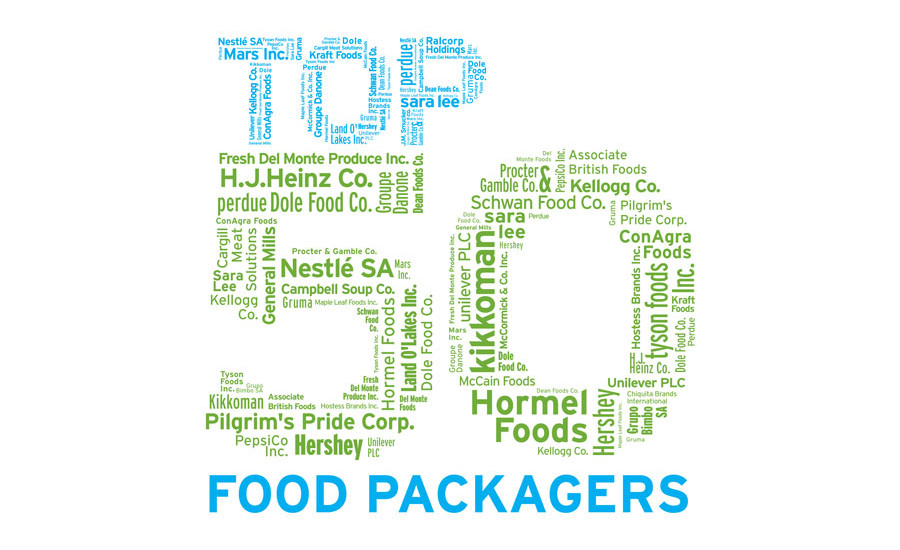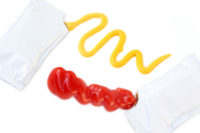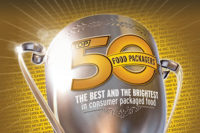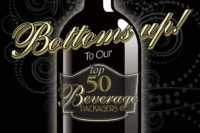Top 50 Food Packagers: Billion dollar brands, multibillion dollar companies

by Rick Lingle, Editor-in-Chief
The more things change the more they stay the same. That’s certainly true in our exclusive, annual rankings of the Top 50 Food Packagers (click here to a link to the PDF of the chart). As detailed in the methodology note listing with the chart, the rankings are based on 2010 sales revenues or from the corresponding fiscal year.
For example, the cutoff in last year’s list for what would have been the 50th food packager company was $2.1 billion. Coincidentally-give or take a hundred million dollars-that’s the same cutoff point for this year’s list.
Another sure thing is that you can count on Nestlé SA and Kraft Foods to remain one and two respectively. They did it again this year as they have for the last four years in a row.
Those same leading companies were involved in major business deals that reshuffled the brands and consumer packaged goods landscape. In 2010, Kraft sold the DiGiorno and Delissio brands, along with the rest of its frozen pizza business, to Swiss-based food manufacturer Nestlé. According to Bloomberg, this move helped finance Kraft’s bid for Cadbury, while also effectively ensuring that Nestlé would not submit a competing bid for the confectionery company. Cadbury is of course gone from our list having been absorbed into Kraft; Cadbury itself was #17 last year with $9.36 billion in revenues, which would have placed it in that same position again this year ahead of Campbell Soup.
It was in 2006 that Tyson Foods held the runner-up spot to perennial paramount Nestlé, which remains distantly entrenched at the top. It’s understandably challenging for a packager of protein-based foods to keep pace with a nimble giant like Kraft that spans the entire spectrum of packaged foods. Kraft, at $36 billion, appears settled comfortably into the runner-up spot.
Our third slot looks to be more competitive, with Mars Inc., Tyson Foods, and PepsiCo all bunched around the $30 billion mark.

For example, #2 Kraft Foods has 11 brands that top $1 billion in annual sales including Oreo, Nabisco, Maxwell House, and Oscar Mayer meats. Just as impressive, Kraft’s portfolio contains 70 brands that each generate annual revenues of more than $100 million-that’s $7+ billion right there, enough to make the Top 20 on our list.
PepsiCo has even more: 19 brands that generate more than $1 billion of retail sales each - and that’s sharply up from 11 in 2000. Providing snacks that make people thirsty is a synergistically paired business strategy.
Not to be outdone, Nestlé owns 20 brands that have annual sales of over CHF 1 billion (US$1.2B)
Putting it in perspective, each of those $1 billion brands’ sales is higher than the Gross Domestic Product of The Netherlands or Turkey.
Companies like these do not get where they are by sitting tight, but continue to push on the innovation accelerator. For Nestlé, that’s through three growth drivers: nutrition, health and wellness. It looks to emerging markets for opportunities to provide nutritious, affordable, branded food to lower income consumers around the world. The packager also notes that out-of-home consumption is growing faster than in-home and opportunity in premium products.
Also, incomes are increasing as is leisure time. These are just two trends that point to accelerated growth in premium food and drinks. Nestlé notes that each of its product categories has its own specific premium strategy, encompassing brands such as Nespresso and Häagen-Dazs.
Big picture consciousness
“We are the second-largest food and beverage business in the world, and the largest food and beverage business in North America,” states Indra K. Nooyi, PepsiCo chairman and chief executive officer. “We are investing in a healthier planet by reducing water usage, increasing recycling levels and minimizing our carbon footprint.”
The packaging component to products continues to grow in importance, pulled along as corporate social responsibility and sustainability programs have gained prominence.
All those brands require a lot of packaging, for sure, but a raised environmental consciousness has resulted in concerted efforts to use less packaging than in the past. Nestlé reported that in 2010 the company consumed 4.6 million tonnes (5 million U.S. tons) of packaging materials, a weight reduction of 70,828 tonnes (78 million tons) from 2009.
Likewise, Kraft reported this spring that, from 2005 through 2010, its energy use is down 16 %, net waste is down 42 %, and packaging has been reduced 100,000 metric tons (200 million lb). More is planned. Going forward and from a 2010 base, by the end of 2015 Kraft Foods plans include eliminating 50,000 metric tons (100 million lb) of packaging material.
The on again, off again progress away from the recession remains somewhat unsteady due to the wild card of other geopolitical factors. At the time of this report in July, it appeared the economy was again heading forward. Nestlé, for one, is “confident” that so-called organic revenue will rise 5 to 6% in 2011.
That makes one wonder: If a rising tide lifts all boats, does that mean that the bigger “boats” will be lifted higher? Time, as always, will tell. F&BP

That’s what General Mills did in early 2011 with the successful line of Green Giant brand Valley Fresh Steamers. And successful it has been: The microwave-in-the-bag vegetables with sauce ranked a heady No. 4 among the top 10 most successful new products in the United States in 2009, according to industry analysts Information Resources, Inc. (IRI). A package innovation debuting in January makes it even easier for consumers to prepare the microwave-in-bag vegetables with sauce: The Green Giant cook sensor. Available on four Valley Fresh Steamers Healthy Colors products, the cook sensor gives consumers a clear visual signal that the microwaved vegetables are ready to eat. The word DONE appears on the packaging when the food inside has reached its optimal cooking point.




After a challenging several years, the overall economy and the packaging industry have exhibited encouraging signs of recovery. Despite economic uncertainties that linger, the positive momentum in the economy has led to a notable resurgence in mergers and acquisitions (M&A) in 2010. The packaging industry has participated significantly in this trend.
It is important to note from the accompanying graphic that aggregate deal value and the number of deals have increased meaningfully between 2009 and 2010.
Both strategic and private equity valuations for packaging M&A transactions in 2010 have improved over 2009, but have remained notably below the pre-recession levels.
Strategic buyers have come off the sidelines to fuel their growth objectives via strategic acquisitions. Such acquisitions are typically driven by cost synergies as well as opportunities for geographic and product line expansion.
Key deals over the past year
Among the most notable packaging transactions in 2010 involving a strategic acquirer included:
• Reynolds/Rank Group’s acquisition of Pactiv
• Bemis’s acquisition of Alcan Food Americas
• Amcor’s acquisition of Alcan Global Pharmaceutical Packaging
• Graham Packaging’s acquisition of Liquid Container
• Sonoco’s acquisition of Associated Packaging Technologies
• Greif’s acquisition of Storsack
Private equity firms have been important and active participants in packaging M&A activity over the last several years, and continued the trend in 2010. According to Mesirow Financial research, approximately 60% of packaging M&A in 2010 was backed by private equity firms, which were attracted to packaging for several reasons, including that the industry has proven to be less cyclical than other notable sectors. F&BP
Sources: Miserow Financial (www.mesirowfinancial.com) via Packaging Strategies (www.packstart.com), Food & Beverage Packaging.
Trends in machinery play a fundamental role in packaging. Charles D. Yuska, president and CEO of the Packaging Machinery Manufacturers Institute (PMMI), cites these trends that were seen on the floor at PACK EXPO International 2010 and that will again be evident at this fall’s PACK EXPO Las Vegas:
• Increased integration at all levels - component, machine-to-machine and beyond the line to plant and enterprise - and greater functionality with greater ease of use
• Increased functionality with simpler controls and operator interfaces
• Sustainability improvements - renewable materials, recycled content, source reduction, waste minimization and sustainable machines
• Brand power: convenience & shelf appeal
• Serialization and food safety solutions that respond to looming pharmaceutical pedigree deadlines and tracking and protecting efforts in food processing
• New technologies, such as digital printing and augmented reality, that help create new relationships with customers.
The more things change the more they stay the same. That’s certainly true in our exclusive, annual rankings of the Top 50 Food Packagers (click here to a link to the PDF of the chart). As detailed in the methodology note listing with the chart, the rankings are based on 2010 sales revenues or from the corresponding fiscal year.
For example, the cutoff in last year’s list for what would have been the 50th food packager company was $2.1 billion. Coincidentally-give or take a hundred million dollars-that’s the same cutoff point for this year’s list.
Another sure thing is that you can count on Nestlé SA and Kraft Foods to remain one and two respectively. They did it again this year as they have for the last four years in a row.
Those same leading companies were involved in major business deals that reshuffled the brands and consumer packaged goods landscape. In 2010, Kraft sold the DiGiorno and Delissio brands, along with the rest of its frozen pizza business, to Swiss-based food manufacturer Nestlé. According to Bloomberg, this move helped finance Kraft’s bid for Cadbury, while also effectively ensuring that Nestlé would not submit a competing bid for the confectionery company. Cadbury is of course gone from our list having been absorbed into Kraft; Cadbury itself was #17 last year with $9.36 billion in revenues, which would have placed it in that same position again this year ahead of Campbell Soup.
It was in 2006 that Tyson Foods held the runner-up spot to perennial paramount Nestlé, which remains distantly entrenched at the top. It’s understandably challenging for a packager of protein-based foods to keep pace with a nimble giant like Kraft that spans the entire spectrum of packaged foods. Kraft, at $36 billion, appears settled comfortably into the runner-up spot.
Our third slot looks to be more competitive, with Mars Inc., Tyson Foods, and PepsiCo all bunched around the $30 billion mark.

What makes a food company a top food company?
What makes a food company a top food company? In a word, brands. Big brands make for big sales volumes that make for big companies.For example, #2 Kraft Foods has 11 brands that top $1 billion in annual sales including Oreo, Nabisco, Maxwell House, and Oscar Mayer meats. Just as impressive, Kraft’s portfolio contains 70 brands that each generate annual revenues of more than $100 million-that’s $7+ billion right there, enough to make the Top 20 on our list.
PepsiCo has even more: 19 brands that generate more than $1 billion of retail sales each - and that’s sharply up from 11 in 2000. Providing snacks that make people thirsty is a synergistically paired business strategy.
Not to be outdone, Nestlé owns 20 brands that have annual sales of over CHF 1 billion (US$1.2B)
Putting it in perspective, each of those $1 billion brands’ sales is higher than the Gross Domestic Product of The Netherlands or Turkey.
Companies like these do not get where they are by sitting tight, but continue to push on the innovation accelerator. For Nestlé, that’s through three growth drivers: nutrition, health and wellness. It looks to emerging markets for opportunities to provide nutritious, affordable, branded food to lower income consumers around the world. The packager also notes that out-of-home consumption is growing faster than in-home and opportunity in premium products.
Also, incomes are increasing as is leisure time. These are just two trends that point to accelerated growth in premium food and drinks. Nestlé notes that each of its product categories has its own specific premium strategy, encompassing brands such as Nespresso and Häagen-Dazs.
Big picture consciousness
“We are the second-largest food and beverage business in the world, and the largest food and beverage business in North America,” states Indra K. Nooyi, PepsiCo chairman and chief executive officer. “We are investing in a healthier planet by reducing water usage, increasing recycling levels and minimizing our carbon footprint.”
The packaging component to products continues to grow in importance, pulled along as corporate social responsibility and sustainability programs have gained prominence.
All those brands require a lot of packaging, for sure, but a raised environmental consciousness has resulted in concerted efforts to use less packaging than in the past. Nestlé reported that in 2010 the company consumed 4.6 million tonnes (5 million U.S. tons) of packaging materials, a weight reduction of 70,828 tonnes (78 million tons) from 2009.
Likewise, Kraft reported this spring that, from 2005 through 2010, its energy use is down 16 %, net waste is down 42 %, and packaging has been reduced 100,000 metric tons (200 million lb). More is planned. Going forward and from a 2010 base, by the end of 2015 Kraft Foods plans include eliminating 50,000 metric tons (100 million lb) of packaging material.
The on again, off again progress away from the recession remains somewhat unsteady due to the wild card of other geopolitical factors. At the time of this report in July, it appeared the economy was again heading forward. Nestlé, for one, is “confident” that so-called organic revenue will rise 5 to 6% in 2011.
That makes one wonder: If a rising tide lifts all boats, does that mean that the bigger “boats” will be lifted higher? Time, as always, will tell. F&BP

Packaging notables: Green Giant sets package sensors to 'DONE'
How do you make a good product better? Enhance the packaging, of course.That’s what General Mills did in early 2011 with the successful line of Green Giant brand Valley Fresh Steamers. And successful it has been: The microwave-in-the-bag vegetables with sauce ranked a heady No. 4 among the top 10 most successful new products in the United States in 2009, according to industry analysts Information Resources, Inc. (IRI). A package innovation debuting in January makes it even easier for consumers to prepare the microwave-in-bag vegetables with sauce: The Green Giant cook sensor. Available on four Valley Fresh Steamers Healthy Colors products, the cook sensor gives consumers a clear visual signal that the microwaved vegetables are ready to eat. The word DONE appears on the packaging when the food inside has reached its optimal cooking point.

Packaging notables: SunChips PLA-bag redux quiets critics
Frito-Lay’s SunChips made a big splash in the name of sustainability when the original petro-based three-layer structure transitioned into a 30% structure made of compostable polylactic acid (PLA) in 2009. Then in April 2010, in conjunction with Earth Day, the snacks giant made a bigger, louder splash with the introduction of a 100% compostable structure across the 5-product line of 10.5-ounce bags. And then the complaints about the bag’s crinkly “loudness” infamously reverberated throughout the media. Frito-Lay heard loud and clear, especially after product sales slid 11%. After reformulating the bag structure to make the noise level more palatable to consumers’ ears, it relaunched a 100% compostable bag in the original variety only. The secret was the adhesive used in the package-substituting a flexible polymer for the more rigid polymer. That did the trick, lowering the noise level by 20 decibels to silence critics.
Packaging notables: Nestlé finds a new pathway for microwave convenience
What do you get when you mix a microwave ready meal in a stand-up format with a self-venting valve? A winner, according to a TNS survey of more than 60,000 consumers who named Nestlé Lean Cuisine Market Creations with steam-in-bag technology as Product of the Year in the frozen food category. Pioneered by Birds Eye in 2006 and named one of the Top 10 packages that have made the biggest consumer impact this decade by Brand Packaging magazine, steam-in-bag products continue to offer packaging-driven innovation. This summer Nestlé Foods took a new route when it introduced eight varieties of Lean Cuisine Market Creations in 10½-ounce stand-up pouches. The packaging breakthrough is a steam release valve on the bag back. A clear film patch applied over a perforated hole in the bag film creates the venting. When consumers buy into packaged convenience, it’s a win-win proposition.
Packaging notables: The convertible clamshell uniquely serves up convenience
The Institute of Packaging Professionals’ annual AmeriStar awards program draws the best in packaging. This year, foodservice played the leading role as the “Best of Show” winner from among more than 100 submissions. This creative, winning package structure delivers on unique needs on both sides of the foodservice counter. The hingeless, polypropylene structure provides significant operational efficiency improvements, as well as product differentiation. It provides consumers with product protection, portability, visibility, insulation, and calibrated moisture release through the inventive integration of vents when the package is in the “closed” orientation. The eye-catching, unique, plate-like package is recyclable where facilities exist, reusable, and formed from a custom, downgauged resin sheet thickness. The package was sponsored by Lansmont Corp., and earned AmeriStar top honors for HAVI Global Solutions.
Packaging Suppliers: M&A deals
The packaging landscape is also affected by what is going on in the supply side.After a challenging several years, the overall economy and the packaging industry have exhibited encouraging signs of recovery. Despite economic uncertainties that linger, the positive momentum in the economy has led to a notable resurgence in mergers and acquisitions (M&A) in 2010. The packaging industry has participated significantly in this trend.
It is important to note from the accompanying graphic that aggregate deal value and the number of deals have increased meaningfully between 2009 and 2010.
Both strategic and private equity valuations for packaging M&A transactions in 2010 have improved over 2009, but have remained notably below the pre-recession levels.
Strategic buyers have come off the sidelines to fuel their growth objectives via strategic acquisitions. Such acquisitions are typically driven by cost synergies as well as opportunities for geographic and product line expansion.
Key deals over the past year
Among the most notable packaging transactions in 2010 involving a strategic acquirer included:
• Reynolds/Rank Group’s acquisition of Pactiv
• Bemis’s acquisition of Alcan Food Americas
• Amcor’s acquisition of Alcan Global Pharmaceutical Packaging
• Graham Packaging’s acquisition of Liquid Container
• Sonoco’s acquisition of Associated Packaging Technologies
• Greif’s acquisition of Storsack
Private equity firms have been important and active participants in packaging M&A activity over the last several years, and continued the trend in 2010. According to Mesirow Financial research, approximately 60% of packaging M&A in 2010 was backed by private equity firms, which were attracted to packaging for several reasons, including that the industry has proven to be less cyclical than other notable sectors. F&BP
Sources: Miserow Financial (www.mesirowfinancial.com) via Packaging Strategies (www.packstart.com), Food & Beverage Packaging.
Packaging Machinery Trends
Packaging Machinery TrendsTrends in machinery play a fundamental role in packaging. Charles D. Yuska, president and CEO of the Packaging Machinery Manufacturers Institute (PMMI), cites these trends that were seen on the floor at PACK EXPO International 2010 and that will again be evident at this fall’s PACK EXPO Las Vegas:
• Increased integration at all levels - component, machine-to-machine and beyond the line to plant and enterprise - and greater functionality with greater ease of use
• Increased functionality with simpler controls and operator interfaces
• Sustainability improvements - renewable materials, recycled content, source reduction, waste minimization and sustainable machines
• Brand power: convenience & shelf appeal
• Serialization and food safety solutions that respond to looming pharmaceutical pedigree deadlines and tracking and protecting efforts in food processing
• New technologies, such as digital printing and augmented reality, that help create new relationships with customers.
Looking for a reprint of this article?
From high-res PDFs to custom plaques, order your copy today!







